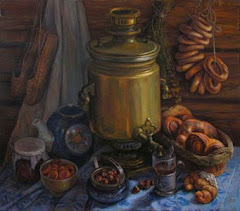
Hooray for the aubergine season! I love aubergines, but absolutely hate cooking them because they always turn out either too oily or burnt. The present recipe just can't go wrong, it's easy, fast, and delicious!
This very popular dish has a somewhat ironic name : when sturgeon caviar, a luxury gourmet item was very hard to get (which, according to some adepts of conspiracy theories, was an artificial phenomenon attempted by the government), a vegetable counterpart was made available everywhere. The cold guacamole-type vegetable spread was sold in glass jars, and as it is the case of all of soviet food, prepared according to gouvernment standarts of taste. (side note: this is not a joke – the food produced by the government, that is anything you could get in canteens all over our huge country tasted exactly the same, because rules had to be followed. The memory of some of our national soviet recipes often triggers disputes amongst foodies : was that 20 kopek sweet bun from the school canteen delicious or despicable? And as some spend years trying to reproduce the lost and forgotten taste of their nostalgia, others shudder with disgust, turning their backs on years of food dictatorship without regret).
Most people who spent their childhood in the soviet era remember the startling aspect of another type of Caviar From Overseas: courgette caviar, which was a bright orange (!) puree. It is still made in Germany and shipped to Russian food stores all over Europe : some people even buy it. I certainly prefer home-made anything to anything made in a food factory, especially if it’s a fluorescent vegetable puree.
The process is the same for any type of vegetable ikra; the difference is made by the main ingredient which should be used in at least a 3:1:1 proportion, where for instance you would have three times as many aubergines or courgettes as carrots and onions. Everything should be adjusted to one’s taste, and once you’ve made this dish, it will be easier to manage the quantities and proportions. Some people add more onions, some leave them out – it’s all up to you!
So, here are our ingredients! As always, some are optional, and used in certain regions only. On the Black Sea coast, red bell peppers are very popular in this dish, but not necessary.
2 carrots
2 onions
1 red bell pepper (optional)
salt
pepper
cumin
fresh coriander leaves (optional)
2 cups of water
1. Dice all the veggies. Some people cut them in large bits, others chop the vegetables finely and puree them after they're cooked. I prefer some texture, and never puree the vegetables.
2.Now, the process differs from cook to cook. Some like to sautee onions and carrots in vegetable oil first, than add aubergines, water, and simmer till ready. This was the way I used to make it before.
Now I prefer a low-fat cooking method which is also easier, namely : slow cook or simmer all ingredients together at the same time. It’s a real time saver, and I find the aubergines taste much better this way!
3. Make sure there is at least some water at the bottom of the pan at all times. You will need to turn the vegetables over from time to time and add some water if necessary. When the carrots are soft, everything else should be cooked too.
4. Serve in a bowl with some bread on the side. Be careful not to bite your fingertips off and Bon appetit!

